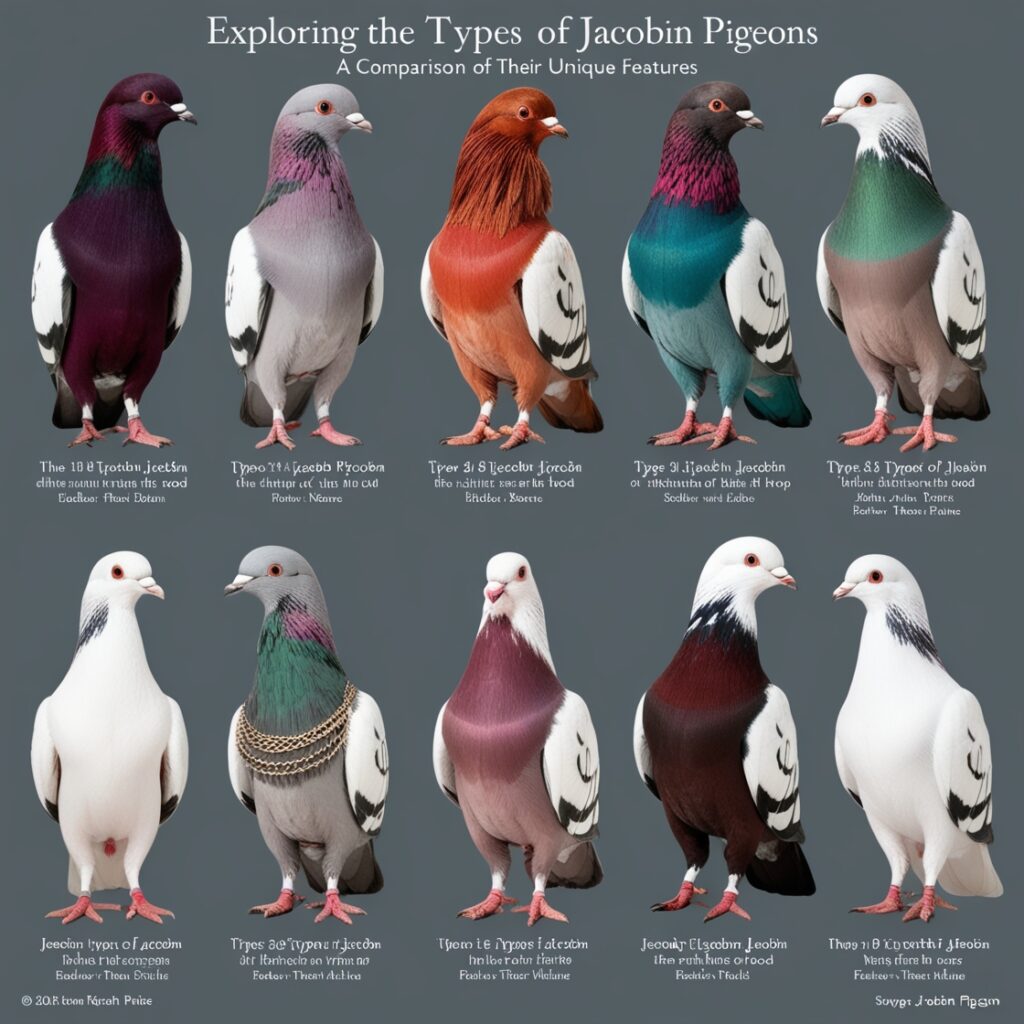Jacobin Pigeons with Unique Features and Types
Jacobins is A Unique and Regal Pigeon Breed
The Jacobin pigeon stands out as one of the most striking and distinguished breeds within the world of domestic pigeons. Renowned for its extraordinary appearance, particularly its unique feather arrangement known as a “hood,” the Jacobin is often described as regal and aristocratic. This breed has captured the admiration of pigeon fanciers for centuries, not only due to its unique look but also because of its gentle temperament.
Physical Features
The defining characteristic of the Jacobin pigeon is its hood, a distinctive feature formed by long feathers that cover the head and neck. This feather arrangement creates an impressive, almost crown-like appearance that makes the Jacobin easily recognizable among other pigeon breeds. The hood can vary in fullness and length, contributing to the bird’s overall allure.
In addition to the hood, Jacobins have a robust and compact body with a strong neck and well-proportioned wings. Their heads are rounded, and they typically have short beaks. The eye color can vary, but they often have bright, expressive eyes that enhance their noble demeanor.
e.
Definition and Origins of Jacobins
The Jacobin pigeon is a remarkable breed of fancy pigeon that has been meticulously developed over many years through selective breeding practices. The breed’s name is inspired by the Jacobin monks, who were known for their distinctive hooded robes, resembling the pigeon’s unique feathered hood. This hood elegantly covers the bird’s head and neck, contributing to its striking silhouette, which is both dramatic and aesthetically pleasing.
The Jacobin’s impressive appearance, coupled with its gentle temperament, makes it a favored choice among pigeon enthusiasts and fanciers alike. Its captivating look and regal demeanor have solidified its place in the world of ornamental pigeons, where it is often showcased in exhibitions and competitions.
Key Features of the Jacobin Pigeon
- Hood: The most distinguishing feature of the Jacobin is its feathered hood, which varies in fullness and style among individuals. This characteristic not only defines the breed but also adds to its visual appeal.
- Body Structure: Jacobins typically possess a robust and compact body, with a well-proportioned physique that complements their grand hood.
- Temperament: Known for their calm and friendly nature, Jacobin pigeons are easy to handle, making them excellent pets for both novice and experienced fanciers.

Types of Jacobins
While Jacobin pigeons are best known for their iconic hoods, breeders have skillfully developed various types based on the degree of feather development and structure. The three primary areas of focus in Jacobin breeding are the hood, mane, and chain feathers. Here’s a closer look at the different varieties of Jacobins:
Varieties of Jacobin Pigeons
- Classic Jacobin:
- This is the most prevalent type of Jacobin. The hood completely envelops the bird’s head, creating a striking halo effect.
- The mane feathers elegantly curve down the back of the neck, enhancing the bird’s overall grace.
- The chain feathers at the front form a structured frame around the face, giving the Classic Jacobin a well-defined appearance.
- Exhibition Jacobin:
- Bred specifically for competitive shows, Exhibition Jacobins are selected for their exceptionally well-developed hoods.
- These birds are highly prized in competitions for their perfect posture, balanced proportions, and dense feathering.
- Their impressive appearance often sets the standard in Jacobin exhibitions, making them a favorite among fanciers.
- Standard Jacobin:
- Standard Jacobins feature a less exaggerated hood but still possess the graceful and ornate feathering that defines the breed.
- While they may be more practical for breeding purposes, they retain the unique traits that make them visually distinct and attractive to pigeon enthusiasts.
Color Variations
One of the most appealing aspects of Jacobin pigeons is their wide array of color variations. Through selective breeding, enthusiasts have developed a rich palette of hues, enhancing the breed’s aesthetic diversity. Common colors include:
- White: Pure white Jacobins showcase their elegant structure and hoods beautifully.
- Black: Dark-feathered Jacobins offer a striking contrast to their feathered hoods.
- Blue: Soft blue hues are popular for their classic and timeless look.
- Red: Vibrant red Jacobins stand out for their bold appearance.
- Pied and Patterned Variations: These include combinations of colors, such as white with patches of other colors, adding further uniqueness to the breed.
The combination of the Jacobin’s distinctive feathering and the variety of colors available makes this breed highly sought after among pigeon fanciers, contributing to its status as one of the most elegant and admired breeds in the fancy pigeon community.

Breeding Season
Jacobins typically breed during the spring and summer months. Like many pigeon species, they are monogamous and form strong pair bonds. The male courts the female through a series of behaviors, including cooing, strutting, and puffing up his feathers. Once they have formed a pair, the female lays two eggs, which both parents take turns incubating for approximately 17 to 19 days.
Raising Chicks
After hatching, the chicks are fed a nutrient-rich substance known as pigeon milk, which is secreted from the parents’ crops. This diet continues for the first week or two, after which the chicks gradually transition to solid food. Jacobin parents are attentive and protective, ensuring their young are well-fed and safe.
Feather Development
As young Jacobins grow, their characteristic hood feathers begin to develop, usually after a few weeks. By the time they reach four to six months of age, their distinctive hood, mane, and chain feathers become fully pronounced, signaling their maturation into adulthood.
Molting and Maintenance
Like all pigeons, Jacobins undergo an annual molting process in which old feathers are replaced with new ones. This molting is crucial for maintaining vibrant plumage. During this period, extra care must be taken to ensure that they receive sufficient nutrition to support feather growth.
Lifespan
Jacobins can live for 10 to 15 years, with some individuals even reaching up to 20 years under optimal care. Their lifespan is influenced by various factors, including diet, living conditions, and genetics. Regular veterinary care and a balanced diet play a key role in ensuring a long and healthy life for these magnificent birds.
Types of Jacobins: An In-Depth Exploration of a Unique Pigeon Breed
Jacobins are among the most visually striking pigeon breeds, easily identifiable by their unique feather structure. Bred over centuries, the Jacobin pigeon is particularly known for its distinct hood of feathers that encases its head and neck. This breed is not only cherished for its aesthetic appeal but also for the rich diversity within its types, feather structures, and show standards. Each variety of Jacobin pigeon possesses unique qualities and traits, carefully refined through generations of selective breeding. This article will provide an in-depth look at the different types of Jacobins, examining their defining characteristics, differences, and the traits that make them highly sought after among pigeon enthusiasts.

Historical Context of Jacobins
The Origin of the Jacobin Breed
Before we delve into the various types of Jacobins, it’s important to understand the breed’s origins. Jacobins were initially bred in Asia, particularly in India and Persia, before making their way to Europe in the 16th century. The breed gets its name from the Jacobin monks, who wore hooded robes that resemble the pigeon’s distinctive feather arrangement. Over time, European breeders refined the bird’s characteristics, placing an emphasis on the size and structure of the hood to create a pigeon that embodies both grace and presence. Today, Jacobins are regarded as some of the most prestigious show pigeons, admired for their striking appearance and elegance.
The Feather Structure of Jacobins
To appreciate the different types of Jacobins, one must first understand the unique feather structure that defines the breed. Jacobins are characterized by three main feather regions: the hood, the mane, and the chain.
The Hood:
The hood is the defining feature of the Jacobin breed. It consists of a full, circular arrangement of feathers that encircles the bird’s head, forming a protective layer. A hood that is more complete and dense is generally more desirable for show purposes.
The Mane:
The mane comprises the feathers that flow down the back of the bird’s neck, extending from the hood. This feature enhances the Jacobin’s sleek appearance and is critical for judging the bird’s aesthetic qualities. An ideal mane should lie flat and smooth against the body, creating a streamlined look.
The Chain:
The chain refers to the front portion of the hood that frames the face of the pigeon. This area features tighter feathering and should form a balanced, symmetrical ring around the face. A well-defined chain contributes to the bird’s refinement, enhancing its overall elegance.
Types of Jacobins
Through selective breeding, various types of Jacobins have been developed based on their hood size, feather density, and overall appearance. Although Jacobins belong to a single breed, the variations in their feather structure and refinement have led to distinct categories within the breed. Below are the primary types of Jacobins:

-
Moderate Hood
Standard Jacobins feature a hood that is full and rounded, though not as pronounced as that found in Exhibition Jacobins. The feathers are dense and well-formed, allowing the bird’s face to remain partially visible. This design makes Standard Jacobins easier to care for and more practical for breeding purposes.
Balanced Mane and Chain
In Standard Jacobins, the mane is sleek and lies close to the body, while the chain is well-defined but not as tight or refined as in Exhibition Jacobins. These characteristics give Standard Jacobins a balanced and elegant look, making them a popular choice among breeders seeking show-quality birds that require less maintenance.
Practicality
Standard Jacobins tend to be more robust than their Exhibition counterparts, making them better suited for both breeding and everyday care. They are less susceptible to feather damage and require less grooming, making them a practical option for breeders who wish to preserve the breed’s distinctive features without the additional effort required by Exhibition Jacobins.

